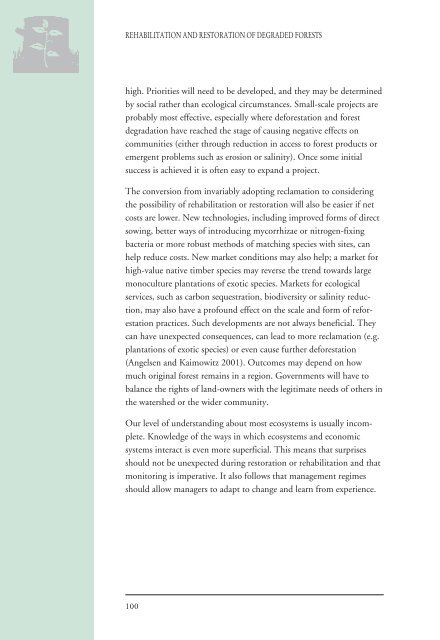Rehabilitation and Restoration Of Degraded Forests (PDF) - IUCN
Rehabilitation and Restoration Of Degraded Forests (PDF) - IUCN
Rehabilitation and Restoration Of Degraded Forests (PDF) - IUCN
You also want an ePaper? Increase the reach of your titles
YUMPU automatically turns print PDFs into web optimized ePapers that Google loves.
REHABILITATION AND RESTORATION OF DEGRADED FORESTS<br />
high. Priorities will need to be developed, <strong>and</strong> they may be determined<br />
by social rather than ecological circumstances. Small-scale projects are<br />
probably most effective, especially where deforestation <strong>and</strong> forest<br />
degradation have reached the stage of causing negative effects on<br />
communities (either through reduction in access to forest products or<br />
emergent problems such as erosion or salinity). Once some initial<br />
success is achieved it is often easy to exp<strong>and</strong> a project.<br />
The conversion from invariably adopting reclamation to considering<br />
the possibility of rehabilitation or restoration will also be easier if net<br />
costs are lower. New technologies, including improved forms of direct<br />
sowing, better ways of introducing mycorrhizae or nitrogen-fixing<br />
bacteria or more robust methods of matching species with sites, can<br />
help reduce costs. New market conditions may also help; a market for<br />
high-value native timber species may reverse the trend towards large<br />
monoculture plantations of exotic species. Markets for ecological<br />
services, such as carbon sequestration, biodiversity or salinity reduction,<br />
may also have a profound effect on the scale <strong>and</strong> form of reforestation<br />
practices. Such developments are not always beneficial. They<br />
can have unexpected consequences, can lead to more reclamation (e.g.<br />
plantations of exotic species) or even cause further deforestation<br />
(Angelsen <strong>and</strong> Kaimowitz 2001). Outcomes may depend on how<br />
much original forest remains in a region. Governments will have to<br />
balance the rights of l<strong>and</strong>-owners with the legitimate needs of others in<br />
the watershed or the wider community.<br />
Our level of underst<strong>and</strong>ing about most ecosystems is usually incomplete.<br />
Knowledge of the ways in which ecosystems <strong>and</strong> economic<br />
systems interact is even more superficial. This means that surprises<br />
should not be unexpected during restoration or rehabilitation <strong>and</strong> that<br />
monitoring is imperative. It also follows that management regimes<br />
should allow managers to adapt to change <strong>and</strong> learn from experience.<br />
100

















